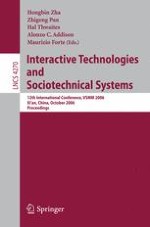2006 | Buch
Interactive Technologies and Sociotechnical Systems
12th International Conference, VSMM 2006, Xi’an, China, October 18-20, 2006. Proceedings
herausgegeben von: Hongbin Zha, Zhigeng Pan, Hal Thwaites, Alonzo C. Addison, Maurizio Forte
Verlag: Springer Berlin Heidelberg
Buchreihe : Lecture Notes in Computer Science
